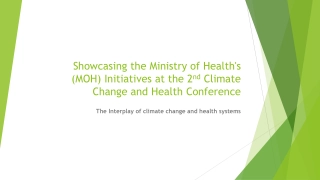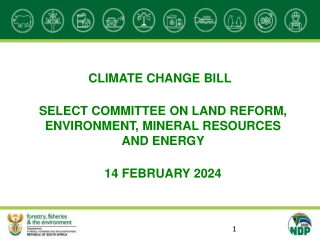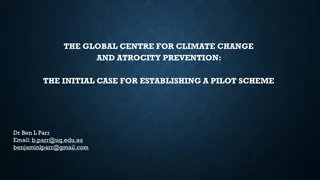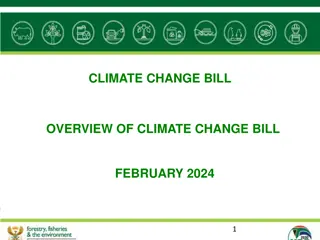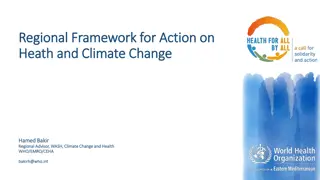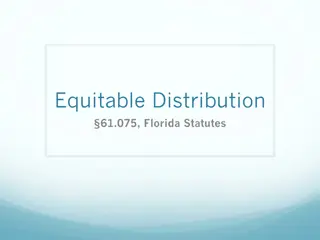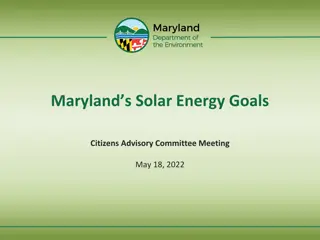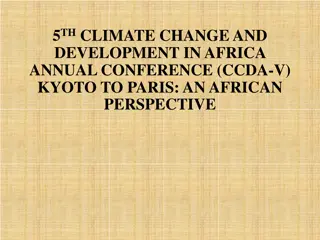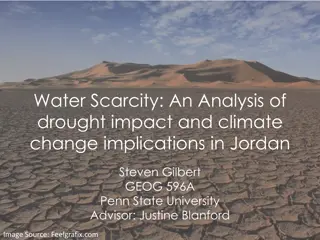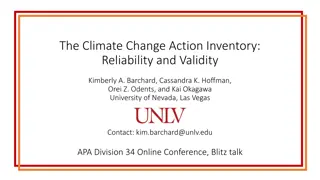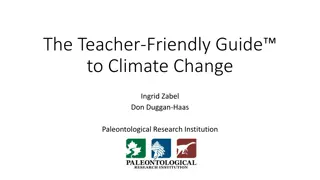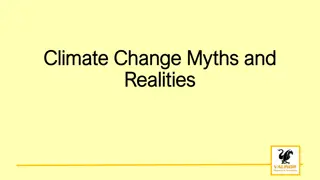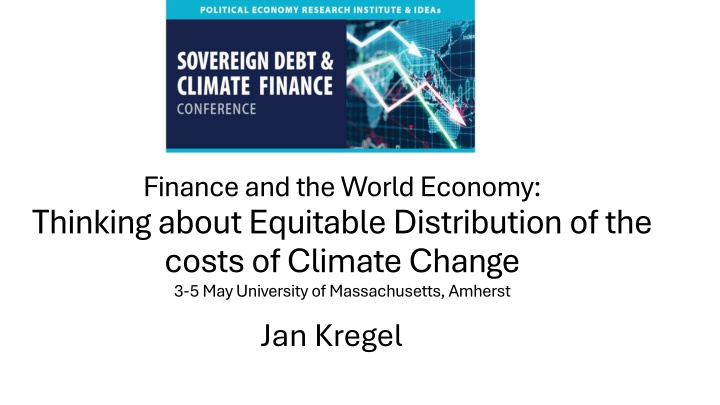
Equitable Distribution of Climate Change Costs
In the world economy, the distribution of costs related to climate change is a topic of concern. Issues like maldistribution of capital, labor migration, and global coordination to respond to natural resource changes are discussed. The constraints on global responses and suggested solutions such as eliminating national boundaries, trade impediments, and financial constraints are explored towards achieving a more balanced and sustainable economic structure.
Download Presentation

Please find below an Image/Link to download the presentation.
The content on the website is provided AS IS for your information and personal use only. It may not be sold, licensed, or shared on other websites without obtaining consent from the author. If you encounter any issues during the download, it is possible that the publisher has removed the file from their server.
You are allowed to download the files provided on this website for personal or commercial use, subject to the condition that they are used lawfully. All files are the property of their respective owners.
The content on the website is provided AS IS for your information and personal use only. It may not be sold, licensed, or shared on other websites without obtaining consent from the author.
E N D
Presentation Transcript
Finance and the World Economy: Thinking about Equitable Distribution of the costs of Climate Change 3-5 May University of Massachusetts, Amherst Jan Kregel
Maldistribution--Sans Frontiers Capital is globally mobile We encourage global capital flows developed to developing countries Source of financial instability Domar-Minsky Labour is not We discourage global labour migration Source of political instability Climate change makes it imperative Information faces no constraint digital communications
Ability to respond to global changes Natural resources are (randomly) globally mobile Water in its various forms: ice -vapor -moisture Agricultural conditions Gradient adjustments public safety Crisis resolution Calls for Global Coordination An Economic Security Council ? Ability to respond hampered by rise of Nationalism-populism --NIMBY Global Financial response it hampered by an external constraint Current account balances determined by statistics of cross border flows
Where do these constraints come from Rosenstein Rodan development : solve the problem created by the new national economic boundaries after Versailles Disrupted existing productive structures (we now call them supply chain disruptions) Optimal production area optimal currency area optimal political area How to develop self-sustaining productive structures in these new economic areas By political creation they had unbalanced productive structures First priority internal structural production balance Required a finance (a risk diversified Regional financial trust) It required a Big Push, or a Big Bang or Balanced sectoral Approach This was not Soviet style quantitative planning! Based on recognition of substitution and complementarity in the Keynesian Multiplier
The simple solutions Remove external balance constraints Eliminate national boundaries: Regional associations Reduce trade impediments Remove financial constraint Capital controls (on inflows) Eliminate national currencies Eliminate exchange rates common currency areas Basket/Commodity currencies Multiple exchange rate regimes Replace the US$: with what? Another national currency? But: International Financial Architecture is based on Bilateral Debt The problem is to remove the Ponzi finance of external constraints
it is not only a border problem Climate Damage is a debt pusher it forces countries to borrow Banks create money out of nothing; climate change creates debt out of nothing Think of a hurricane as a mafia offer you can t refuse Or as a debt to Gaia accumulated over time Accumulates faster for countries with lower means to Remediate Geography: SIDS, Production: climate dependent Agriculture No Policy remedies: Good macro policies won t help Not only generates a Maldistribution of debt But also of populations, of water: drought, flood, turbulence We can do something about the people, not the water But emergency financing remains on a bilateral basis And remediation creates contingent debt with no debt service Is there an asset to match the Climate debt
How does this system deal with Climate Change? Remediation/Reparation of Environmental Damage For low-income countries requires extraordinary budget expenditures Think of the hurricane as a Sovereign Climate creditor Reparation may require imports of foreign technology/materials: foreign borrowing This creates a contingent or double debt burden No SDRM is possible with the hurricane you have to pay now with emergency services and repairs So no temporal restructuring is possible No SDRM is possible with Sovereign creditor Gaia The response is Climate remediation Which requires borrowing from developed countries Climate Improvement does not generate debt service It is pure Ponzi finance
Global MalDistributionof Fiscal Policy Space While remediation costs of climate damage is random across borders, the fiscal space to respond is not. Developed countries have the fiscal space to use traditional Keynesian expenditure policies to support domestic incomes. Lerner: the major impact of internal borrowing is domestic redistribution of income; . The proper analogy to the incurrence of internally held national debt is not an individual borrowing from another individual but an individual borrowing money from one of his pockets to put it into another. The basic difference between internal and external deficits: Increasing debt to other countries or to the citizens of other countries does indicate impoverishment of the borrowing country and enrichment of the lending country. The country cannot by monetary manipulations consume more than it can produce.
Remedy the Global MalDistributionof Fiscal Space While climate damage is random across borders, the fiscal space to respond and offset the internal costs is not. For Developed countries Traditional Keynesian expenditure policies can be used to respond to climate change. As Lerner pointed out long ago, as long as debt is held internally the major impact is one of domestic redistribution of income:. The proper analogy to the incurrence of internally held national debt is not an individual borrowing from another individual but an individual borrowing money from one of his pockets to put it into another. For Developing Countries who have limited fiscal space and rely on foreign borrowing: Increasing debt to other countries or to the citizens of other countries does indicate impoverishment of the borrowing country and enrichment of the lending country. The country cannot by monetary manipulations consume more than it can produce. repayment {of foreign currency debt} will constitute a real burden on the country just as the borrowing provided a real benefit quite different from any benefit that can accrue from internal borrowing. When the time comes to make the repayment there may be great inconvenience which could lead to default. But none of these considerations is at all applicable to internally held national debt which from the point of view of the nation cancels out. This means that there is a differential burden on developing countries responding to the crisis in terms of the real costs of servicing the external debt. While debt ratios have been further aggravated in all countries by the increasing interest rates led by developed countries central banks to offset the impact of these events on inflation rates, this further increasing the differential burden placed on developing related to developed countries.
Burden sharing But, in the present context the common methods of dealing with the differential costs generated by the rising debt service are not available: debt forgiveness. No HIPIC process will solve the problems created by the pandemic-environmental- political catastrophes. The debts we are now dealing take the form of what we have borrowed from nature, in the form of environmental degradation, and which now have to be repaid. They are similar to unrequited or odious debt. Nature is not a creditor that can write off these debts, they have to be met. And they cannot be repaid in the normal sense, there is no transfer mechanism that allows this to take place as even the best COP proposals simple serve to stop the borrowing, to stabilize the borrowing from nature at some hypothetical level of temperature increase. And as Diamand and Lerner have emphasized there is no market mechanism to bring about the required measures. The best we can do is an equitable distribution of the costs Current financial arrangements place an inequitable burden on developing countries because they do not have the required fiscal space, technical capacity and are required to resort to bilateral external financing.
Two Possibilties: 1: The Schacht Plan Keynes was not the only one who patterned a global clearing system on the banking principle. While there are no costs related to clearing global deficits by credits, there is an implicit or notional cost for the creditors. Hjalmar Schacht (adopting the position of Adam Smith) noted that the massive gold supplies held after the second war could be used to finance reconstruction. He proposed a transfer of the US earmarked gold supply in Fort Knox to a special German account in the Bank for International Settlements designated for German reparations. He notes that this transfer would create no real cost to the US. A German issuing bank or institution could create a gold backed currency, the Thaler , equal $1 to lend to German enterprises to finance the development of export industries to restore German balance of payments equilibrium. The foreign exchange earnings of the enterprises would be available to repay the Thaler loans. Over an expected reconstruction period of thirty years the export earnings would compensate the US for the gold credits advanced to the BIS. The plan has an additional benefit: since the US gold in Fort Knox did not generate a return, no interest be charged on the transfer of gold, while the Thaler loans would have a positive rate, with could be managed to provide an incentive to the borrower or a source of revenue which could provide additional financial resources for development.
Gold holdings of some of the major central banks February 2024, March 23 Price $2200 per ounce, 1 metric ton is equal to 35273.9619 ounces = $77,602,716.18 United States: 8,133.46 metric tons (MT) = $631,178,587,941.38 Germany: 3,355.14 MT = $257,263,868,516.97 Italy: 2,451.84 MT = $190,269,443,638.77 France: 2,436.75 MT = $189,098,418,651.62 Russia: 2,301.64 MT = ------- China: 2,010.51 MT = $156,021,036,907.05 Switzerland: 1,040 MT = $80,706,824,827.20 Japan: 845.97 MT = $65,649,569,806.79 India: 794.63 MT = $61,663,118,276.63 IMF: 2,814.1 MT = $218,381,803,602.14 Total $1,850,232,672,168.55 Global Estimate $2T According to the most recent Global Landscape of Climate Finance report, the Paris Agreement limiting warming to 1.5C over pre-industrial levels would require US$4 trillion per year on decarbonization before the end of this decade, and over US$6 trillion per year by the 2040s.
How much Gold is in Central Bank Accounts A rough estimate $1.8 T (excluding Russia). But the ABSOLUTE magnitude is not important, since financing is not the problem, Following Schacht a Sustainable Climate Bank could be created to receive the accumulated gold holdings of Developed and Developing countries. However, credits would be for directed to climate remediation expenditures for Developing countries against approval by the Board of the Bank denominated in Climate Thalers backed by gold at the Bank. The funding would not produce export credits, but rather climate amelioration credits in developing countries which could be offset against their earmarked gold accounts in the Bank. This is the equivalent of the redistribution involved in internal financing taken to the global level. What Lerner called the shift from the left pocket to the right pocket, only now it is at the global level. The gold transfers would not be repaid in gold or dollar claims, but they would generate climate improving expenditure credits without direct real costs to the developing countries and improvements in conditions which would be shared globally. Such a program would respond to two needs it would allow developing countries to meet their climate costs without increasing debt service commitments to developed countries or the IMF And without having to reduce domestic incomes to generate the real transfers required by debt service. Second they would provide the equivalent of debt remission which would not require a reduction in developed countries income since they would be paid from the non-remunerative gold holdings. In addition these changes in financing could occur without impact on the domestic monetary policies of the developed countries since these are no longer predicated on gold to back their national currency, as well as being independent of the domestic monetary policy of developing countries. There would be changes in domestic fiscal positions, but these could be easily dealt with by changing the accounting conventions for government expenditures in national accounts. For example, in the past, Germany has allowed special treatment for investment expenditures via the golden rule, and a number of economists, including Keynes, have proposed a special form of fiscal accounting to distinguish current from capital account expenditures. Expenditures to ensure a sustainable environmental future would seen to qualify as part of long-term capital account expenditures, although it is not clear how they would be calculated.
Try an Old Idea: multilateralism Since the problem is not so much the costs of meeting the challenges of global climate change they have to be met and they are real, the basic problem is the global distribution of these costs created by the fact that developed countries can deal with them via creation of internal deficits and debt while this is not available to developing countries. This means the problem has to be dealt with on the level of a global financial institution. We could think of this as designing the global financial system on the pattern of a domestic system, so the question is simply one of looking at the equitable distribution of costs between developed and developing countries. This would mirror the approach Keynes used for a global clearing union based on the extension of what he called the banking principle from the national to the international level. We can think of this as the mirror of Lerner s affirmation that government debt creating deficits cannot produce a real cost since there is always a necessary equality of debits and credits. In such a system, the debts and credits are always internal to the global clearing system and costs are redistributed.
2. Multilateral International Clearing System Original Proposal by Keynes, Schumacher, Kalecki, Balogh Multilateral Clearing of national financial balances Augmented with International Investment Board Possible dedicated/directed finance to Sustainability measures Relocation of displaced populations Commod control For special primary inputs to Sustainability investments Relocation of Food production Schumacher proposals allows retention of national currencies Does not require a global currency (the problem is not the US$ but US financial institutions that dominate financial flows denominated in US$)
Schumacher Amendment: Multilateral Pool Clearing Schumacher proposes a system of Pool Clearing in which importers settle claims in national currency by transfer to their own National Clearing Fund who informs the National Clearing Fund of the exporter who makes payment in domestic currency of the exporter. The surplus receipts of the Pool of deficit countries will invest in domestic Treasury bills which will be held by an International Clearing Office as Trustee the Pools of surplus countries are deemed to own a share in the Pool of differentiated assets equal to the size of their respective surpluses. In this way, one might say, every national currency is made into a world currency, whereby the creation of a new world currency becomes unnecessary. Nor does the International Clearing Office in this connection require any special powers; it is not an agency for control, but a purely administrative body, the central accounting office for the different National Clearing Funds. The Clearing Pools of surplus countries become indebted to their internal money markets and acquire an equivalent share in the Pool; both their debt and their share in the Pool being equal to their trade surplus. The Clearing Funds of the deficit countries are left with cash balances (equal to their trade deficits) invested in domestic assets held by the International Pool. The main force is the fact that the holding of surpluses becomes unprofitable and risky. The surplus, instead of being convertible into gold or interest-earning investments, is tied up in the Pool: it is a share in the Pool. And the Pool s assets are always the weakest currencies of the world: the currencies of the countries that have been unable to earn as much as they have spent. In the present context the Clearing Office could become the financial agent of an International Investment Board or for a Commod management system
We now have the technology for global netting Digital currency Will it be public or private? Public: Central Bank Digital Currency Private Retail accounts held at central banks domestic automatic netting Central banks accounts held with a Global Clearing Union --automatic global netting ??? Do we need the central banks? They provide prudent regulation of private bank liabilities and bank reserves If CBDC accounts replace private bank liabilities: no need for Central Banks Could be done by National Treasury/Finance Ministries They all hold clearing accounts with the Clearing Union Democratic creation of liquidity via national budgets Preserves national currencies
If it is Private: A system patterned on Keynes clearing proposal already exists
Thank you Read more on Modern Applications of the Clearing Union Approach at jankregel.org

